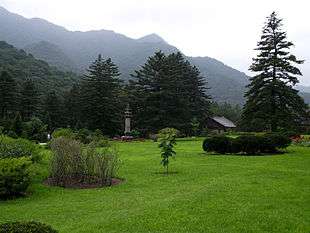Myohyangsan
| Myohyang | |
|---|---|
|
| |
| Highest point | |
| Elevation | 1,909 m (6,263 ft) |
| Coordinates | 40°01′07″N 126°19′59″E / 40.018611°N 126.333056°ECoordinates: 40°01′07″N 126°19′59″E / 40.018611°N 126.333056°E |
| Geography | |
 Myohyang North Korea | |
| Location | North Pyongan Province, North Korea |
| Myohyangsan | |
| Chosŏn'gŭl | 묘향산 |
|---|---|
| Hancha | 妙香山 |
| Revised Romanization | Myohyangsan |
| McCune–Reischauer | Myohyangsan |
Myohyang-san ("Mysterious Fragrant Mountain") is a mountain in North Korea. It is named after the mystic shapes and fragrances found in the area. It is a sacred site as, according to legend, it was the home of King Tangun, forefather of the Korean people.[1]
Tourism
Myohyang is a North Korean tourist attraction and visited by many national tourists. There are several hiking routes on the mountain. Apart from the view, tourists are attracted by the Pohyon temple, built in the 11th century, the Sangwon hermitage, the Kumgang hermitage, and the Habiro hermitage. The Ryongmun cavern is open to the public.
At Myohyang-san is the International Friendship Exhibition centre, dubbed the world's biggest treasure-house. On exhibit are presents received by North Korean leaders over the years.[2] One building stores the presents given to Kim Il-sung, while a smaller one holds those given to his son Kim Jong-il.
The Hyangsan Hotel caters to luxury visitors, while the Chongchon Hotel is second-class.
Environment
Much of the mountain is covered by mixed broadleaf and coniferous forest and protected in a 16,000 hectares (62 sq mi) national park. Some 7,000 hectares (27 sq mi) has been identified by BirdLife International as an Important Bird Area (IBA).[3]
World Biosphere Reserve
In 2009 UNESCO designated Mount Myohyang a world biosphere reserve, citing its cultural significance as well as the spectacular cliffs providing habitat for 30 endemic plant species, 16 plant species that are threatened globally and 12 endangered animal species.[4]
References
- ↑ "Unesco, Mount Myohyang, Democratic People's Republic of Korea". Retrieved 2013-03-01.
- ↑ Soo Kim (9 July 2015). "Train tour to reveal North Korea's 'undiscovered cities'". The Telegraph. Retrieved 11 November 2015.
- ↑ "Mount Myohyang". Important Bird Areas factsheet. BirdLife International. 2013. Retrieved 12 May 2013.
- ↑ Revkin, Andrew C. (2009-05-26). "The New York Times". Dotearth.blogs.nytimes.com. Retrieved 2012-12-21.
External links
- Ryongmun Cavern picture album at Naenara
- Hyangsan Hotel picture album at Naenara
- Another picture album at Naenara
